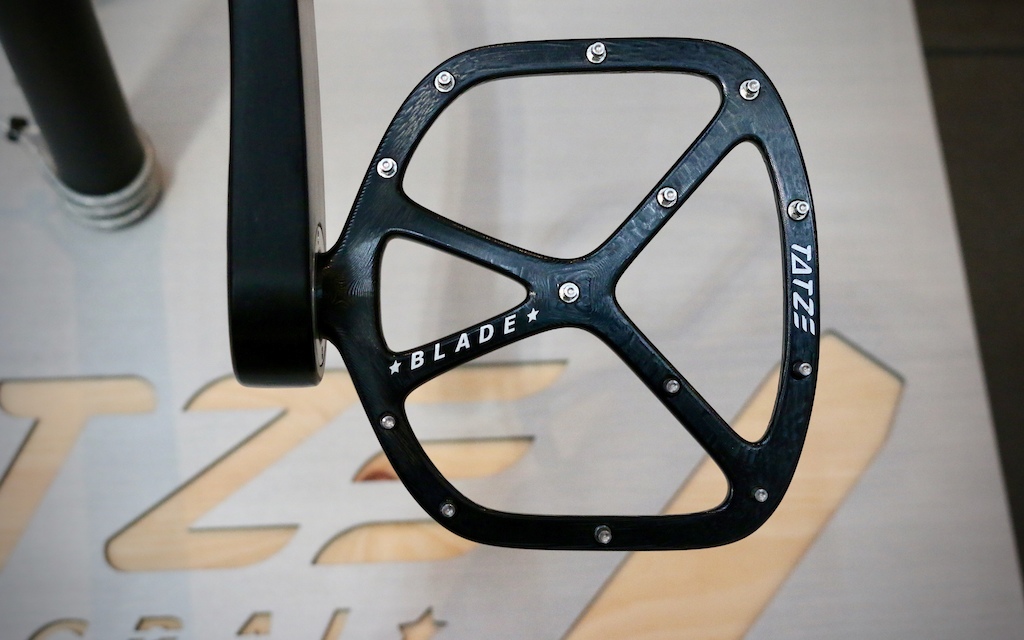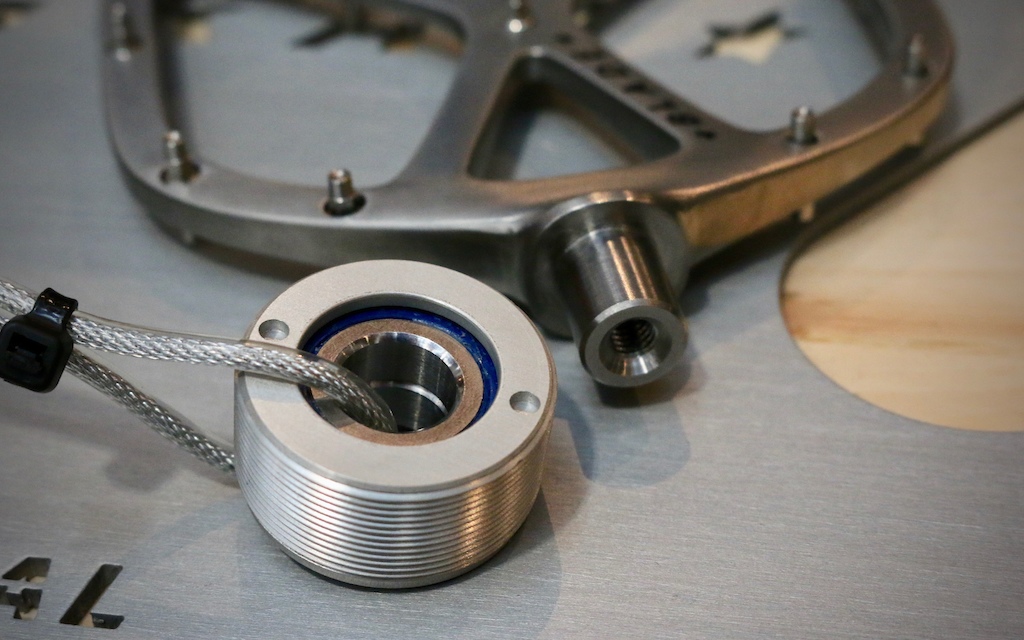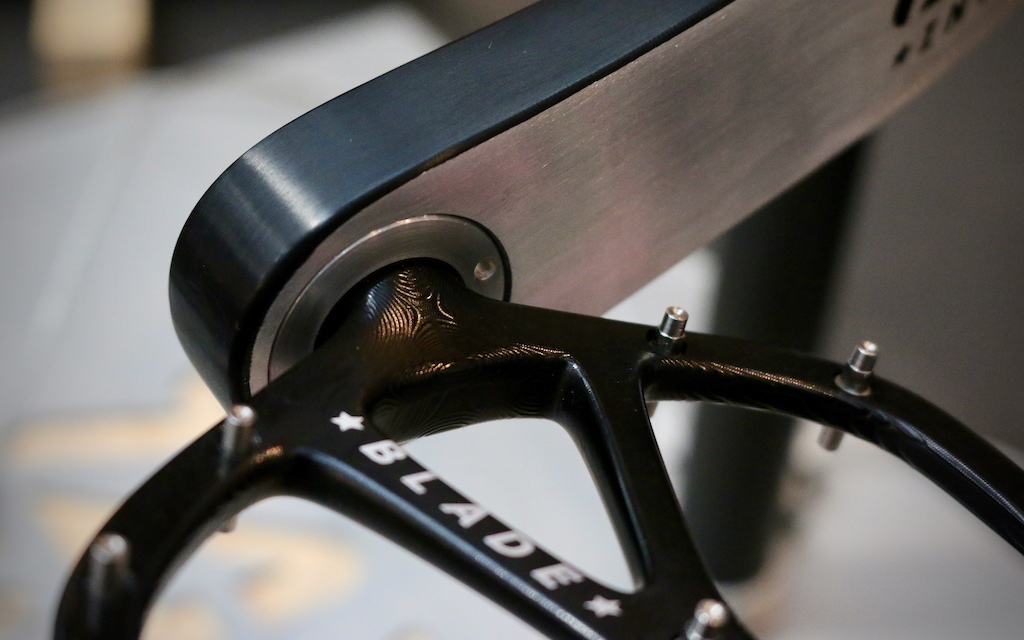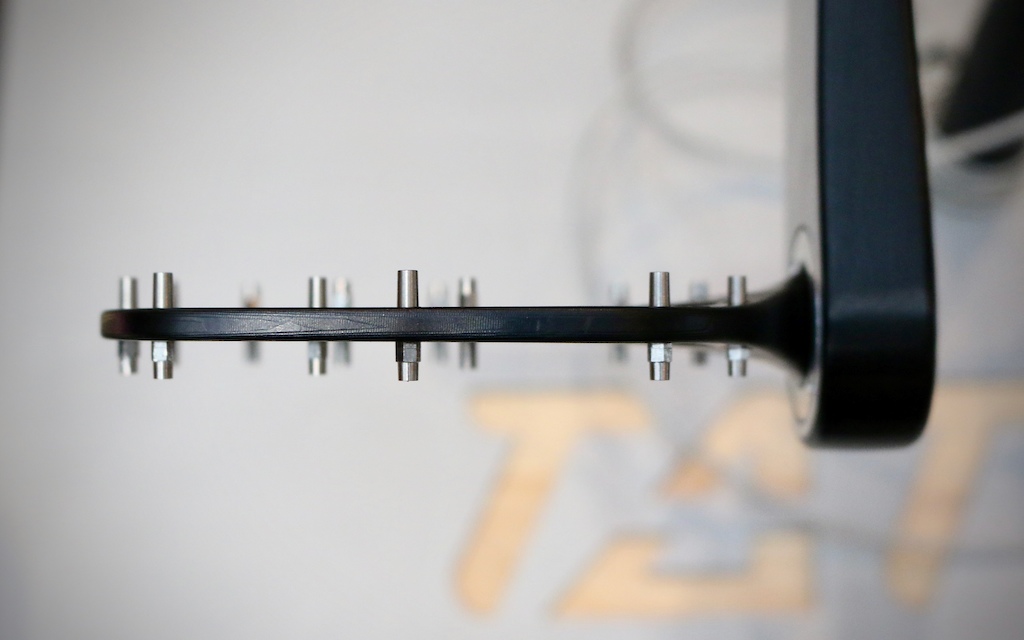Tatze's Pedal is Just 3mm Tall - Eurobike 2019
It's been tried before, but why not try again? Tatze is an Austrian company who've ditched traditional pedal bearings and bushings in favor of having them integrated into their own crankarms. Without needing to squeeze an axle and bearings into the pedal body, they can make it extremely thin: It's just 3mm tall before growing to 9mm up against the crank. The obvious benefit is more ground clearance, but you're also less likely to 'roll and pedal' underfoot.
The two sealed bearings can be much, much larger when they don't need to fit into the pedal, so they should last longer, too.
Two large sealed bearings fit into a socket, and that threads into the crankarm.
The bearings sit in a socket that's then threaded into Tatze's own cranks, and a bolt threaded in from the opposite side attaches the pedal body. Tatze is claiming some low weights: Just 85-grams per pedal for the aluminum version, 100-grams for the titanium model, and only 150-grams for the steel pedals. Platform size is 112mm x 109mm, and the pins thread through the pedal to do double duty on both sides.
Look familiar? There have been a few variations of this idea over the years, the most notable being Momentum's FlyPaper pedals. They required a proprietary set of cranks, which kept the FlyPaper pedals from ever being widely used. Tioga also did a version that saw the bearings sit outside the crankarm, letting you use whatever crankset you want. They didn't stick, either, partly due to the wide Q-factor.
Tatze's Blade pedal is just 3mm tall (or thin?) for most of its width, and 9mm up against the crank.
Who isn't tired of micro-sized pedal bearings dying too quickly? Unfortunately, proprietary cranks will likely keep it from ever being widely used. Here's hoping Tatze sees some success, even if it'll probably take one of the big companies investing in the idea to make it stick around. It makes too much sense not to.
Author Info:
Must Read This Week
[UPDATED] Final Elite XC Results & Overall Standings from the Mairiporã XC World Cup 2024
41983 views
41983 views
Sign Up for the Pinkbike Newsletter - All the Biggest, Most Interesting Stories in your Inbox
PB Newsletter Signup





In other words, I doubt you had anywhere near 3mm of material where it mattered.
step 2. make pedals thin like a knife
step 3. prosthetic lower legs?
2. ???
3. Profit.
I'm expecting the answers to start with "as an engineer..."
They look a bit flexy to me.
for example right now I got bike with 5mm longer cranks than I am used to, it was pretty fine, but I´ve used offset bushings to put the baby a bit lower and slacker and right now it is easy to catch a pedal even on flat ground while turning a peddaling more aggressive and honestly every another mm saved on pedal thickness I would appreciate but yeah, tech climbs is where it counts the most
175 are too big for most people based on std roadie calculations
Imo med bikes should come with 165s, lg should have 170s, and xl 175s.
The reason I assume is cost and convenience, otherwise they have to mess with the gearing on each bike size.
if you are around 6' tall and are riding 175s you can gain that 5mm clearance by switching to 170s and using a
30 tooth chainring to restore the gear ratios. added bonus is log over clearance.
guess which one hits the crank on rocks?
165 on the trail Bike (Stumpjumper evo, f**ing low bb)
And 165 on the DJ bike
Keep it simpel, only need one crank
Shimano Dyna-Drive pedals used the idea in 1982 for road and later for mtn bike
"Dyna-Drive died because the bearings reportedly didn’t last very long and were hard to service"
As long as this stays proprietary though, it won't take off. Like saddles, chains or tires this needs to be a (fairly) universal plug and play design to establish itself in the marketplace.
I'd dig it if that happened.
If they make this to fit everyone's crank arms...arguably one of the few/only stalwart standards left...I bet these take off.
Alright, what about of the weight of the crank then since you can't fit these to anything else.
Shimano gave up on the idea due to durability issues
Stop fixing things that aren't broken.
Also, integrated pedal and cranks sounds expensive, and stupid.
@Milko3D: What pedals would you suggest then? Do you know of some magic pedals with indestructible bearings? I've tried many of them, and they all eventually need service. Raceface, Oneup, spank, dmr, xpedo, VP, etc., all have had bearing failures. Although the Oneup seem to be the best imo so far.
Shimano.
I've not tried enough to know what's the magical pedal, and while I ride a lot and varied terrain, plus some jumps and drops, I'm not the most aggressive rider, and I'm also 60kg...so you know, take it with a spoonful of salt
my tally the now is 480,000ft with 4 months to go for end of year....... if you want it in metres its 150,000m of ascent. if you want my actual mileage its about 2000-2500 miles or 4000km a year, but that includes the descending of which i don't think the descend part is that important other than smashing pedals on rocks, but the ascending is a big deal. due the constant load and grinding on the bearing.
anyway my original comment wasn't meant o be taken as aggressive baiting, apologies if you took it that way and to @Boze74 , am just saying that contrary to the OP thoughts that pedals never die, they definitely do when ridden a lot and in crappy scottish conditions